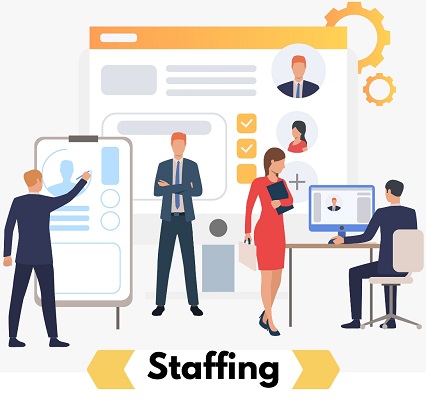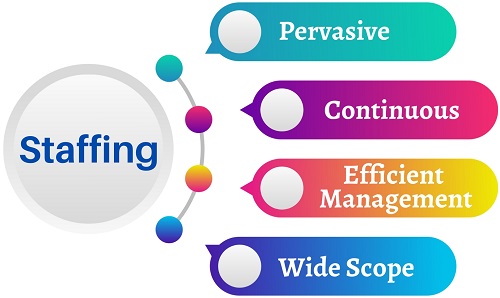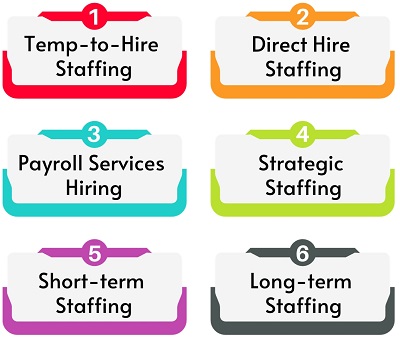If an organization is a Car, then human resources are its Driver. The organization acquires this vital resource through the Staffing function of management. It takes the organization to its ultimate destination, towards short and long-term goals.
Definition: Staffing is a managerial function that involves all the activities from workforce planning and management to developing working relationships with current and future employees. It is a continuous process that deals with the human element in the business.

Simply put, it recruits people who can take up several organizational tasks and responsibilities.
Staffing involves filling out the positions with skilled personnel of the organization, which they create during organizing. Further, it entails keeping the position occupied till the organization continues.
It ensures the employment of the ‘Right Personnel‘ with the ‘Right Skills‘ and achieves a good fit for the person and post. As a result, each personnel perform his share of work efficiently and collectively, achieving organizational objectives.
It begins with ascertaining workforce requirements and ends with career planning. For this purpose, it undertakes certain activities like:
- Attracting Job Seekers
- Acquiring Skilled Personnel
- Training and Development
- Retaining the Staff
Content: Staffing
- Core Staffing Activities
- Nature of Staffing
- Importance
- Staffing Process
- Types
- Features
- Staffing Example
- Staffing vs Recruitment
- Staffing Agencies
- Parting Words
Core Staffing Activities
It is a broader term involving all activities, from finding people to retaining them. The most common activities performed understaffing are as follows:
- Manpower Supply
- Recruitment
- Selection
- Placement
- Training
- Promotion
- Human Resource Inventory
- Retraining
Nature of Staffing
It is a continuous and complex function. This is because, it requires the employment of highly skilled people to occupy the job roles.
During the process, management selects and considers the mentally rich people. They filter candidates at every round and reject the unsuitable ones. Thus, it is a negative process.
The points below explain the nature of the staffing function in management:

- Pervasive: Managers at all levels perform this function. Thus, it is a pervasive function.
- Continuous Function: Besides inception, managers perform staffing functions constantly. All the activities are interdependent and need to be completed in a loop.
- Efficient Management: As an integral part, staffing is practised in all organizations. It brings efficiency by hiring talented and skilled personnel in the enterprise.
- Wide Scope: It has a very broad scope. It includes various activities, from hiring people to compensating them.
Importance
Staffing and organizing tasks go hand in hand. The managers must fill the positions with the right people to perform several tasks.
It is of utmost importance in business as it concerns the business’s most valuable asset, i.e., people. The success and failure of the company depend on its performance and efficiency.
- Investment Cost: The organization invests considerable time, money and effort to form a workforce.
- Holistic Approach: Reporting relationships exist across the organization structure. Therefore, the superiors’ and subordinates’ competency and motivation impact the person’s confidence.
- Long-term Effect: Organizations invest in valuable human assets for the long term. Thus, decisions related to human assets impact the organization as a whole.
- Multiplier Effect: An employee not only performs his job roles, but every action impacts the entire organization.
- Optimum Allocation: Through this function, managers allocate human resources optimally. So they can handle issues like Understaffing and Overstaffing.
Staffing Process
It comprises more than just hiring people with appropriate skill sets or experience. However, it involves many activities that are followed consecutively as a process.
The steps one can follow during the staffing process are furnished below:
- Making estimates about current and future workforce needs.
- Attract and find the most deserving and qualified candidates for the organization.
- Evaluate the candidates based on their skills and experience and select the most deserving ones. After that, assign them a suitable job role.
- Provide required training and development programs to ensure the efficiency of operations.
- Promote the employees and assist them in the transfer process.
- Evaluate and appreciate the employees at periodic intervals.
Types
The six basic types of staffing are as follows:

1. Temp-to-Hire Staffing
It is alternatively known as ‘Contract-to-hire Staffing‘. Here, the organization employs candidates for a limited period, usually one year. They occupy the position for a short duration.
2. Direct Hire Staffing
In Direct Hire or Placement Hiring, organizations hire full-time employees. Manages matches the candidates’ competencies with the company’s vision and mission. The selection process is complex as candidates with rich skill sets are preferred.
3. Payroll Services Hiring
Here, the organization outsources the payroll services to an external company. However, the candidates are shortlisted and selected by the company itself. By doing so, the employees can focus on their dedicated tasks rather than administrative tasks.
4. Strategic Staffing
In this, the companies use a combination of other types of staffing to meet their strategic business needs. In addition, required training and upskill programs to keep them updated.
5. Short-term Staffing
It satisfies the immediate human resource requirement or some emergency. They work temporarily and leave when the particular work is completed.
6. Long-term Staffing
It is a strategic type of staffing with a futuristic approach. The managers think beyond the current requirements and create a skilled and stable workforce.
Features
The features of the staffing function of management are as follows:
- People-centred function of management.
- Managerial Responsibility of placing the right people at the right jobs.
- It involves the recruitment, selection and maintenance of human resources.
- A continuous function that occurs till the company survives.
- It is an invisible function.
- Deals with the current and future staffing requirements.
Staffing Example
Suppose company ORE, dealing in the Bag manufacturing business, is opening a new factory. After creating the organizational structure, they estimated the following human resource requirements:
- 4 Departmental Managers
- 6 Factory Supervisors
- 1200 Workers
- 10 Housekeeping Staff
To occupy the above positions, they took the following steps during the staffing process:
- They published a Newspaper ad announcing vacancies for department managers.
- Transfer of six factory supervisors from their existing factories.
- Hire 1200 workers from the third party on a payroll basis.
- They outsourced the housekeeping services to a company offering such services.
Staffing vs Recruitment
| Basis | Staffing | Recruitment |
|---|---|---|
| Nature of Process | Negative Process | Positive Process |
| Scope | Wide Scope | Small Scope |
| Duration | Long-term | Short-term |
| Number of Steps | Multiple Steps | Single Step |
| Stage | All Stages | Second or Third Stage of the Staffing Process |
Staffing Agencies
It is also known as ‘Employment Agencies‘ performing the recruitment process on the organization’s behalf. It acts as an intermediary between aspiring candidates and the company.
Thus, an organization is believed to meet its objectives only when it has the right persons in the correct positions.
Parting Words
All in all, the bottom line is with human resources, the organization can survive longer. Thus, management is dedicated to ensuring the sufficiency of such resources. Through this process, the company attract job aspirants and selects the appropriate one to fill the requirement.
Lily Bridgers says
You can say that it’s all about finding the right people to drive our company forward without getting bogged down in the recruitment process. We’re just glad to be aware that staffing is a managerial task that includes all of the operations from managing the workforce to establishing working connections with both present and potential personnel. Thanks.